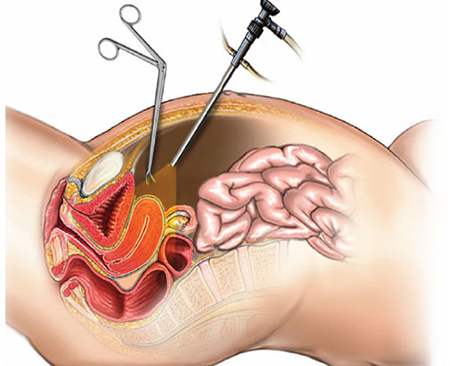
What is Laparoscopy?
In the years before advent of ultrasound, the diagnosis and treatment for most illness was empirical or one had to do an open surgery, if needed, to understand the problem. With ultrasound, many things became easy to identify. However, there are still few conditions which are not well diagnosed an ultrasound and endoscopy still remains the modality of choice for the same. In this procedure a laparoscope is introduced inside the abdominal cavity to directly visualize the uterus/ovaries/ fallopian tubes and pelvic cavity. It help us to assess the tubes and check whether it’s open or not. Look for adhesion in the pelvic cavity or Endometriotic spot in the pelvis which cannot be seen on ultrasound.
Common indications for Laparoscopic procedure are:
Uterine Fibroids
These are noncancerous mass of the uterus. Mainly asymptomatic but can cause pain and heavy bleeding. If medical measures fail to improve the symptoms than there is no choice other than laparoscopic myomectomy/hysterectomy.
Cancer
Cancer of the female genital organs
- Uterus
- Endometrial
- Cervix
- Ovary
Endometriosis
Some extreme pain ultimately leading to infertility also happens. Before hysterectomy is performed in the case of endometriosis, medical procedures and hormone therapy are done.
Adenomyosis
Adenomyosis is caused when the lining of the uterus starts growing into the muscle of the uterus. This leads to the thickening of the uterus wall. It causes heavy bleeding and pain. In the case of Adenomyosis also, hormone therapy and medications are tried first.
Infection
PID also is known as Pelvic Inflammatory Disease leads to severe pelvic pain. It is due to bacterial infection. If found at an early stage, it can get better with antibiotics. But once it spreads it can damage the uterus. Hence doctors suggest a hysterectomy if you have a severe pelvic inflammatory disease.
Hyperplasia
When the lining of the uterus is too thick it causes hyperplasia. Consuming too much of estrogen causes hyperplasia also. Heavy, irregular menstrual bleeding takes place because of hyperplasia also. It can also lead to uterine cancer. If doctors suspect severe hyperplasia they might recommend a hysterectomy also. Doctors recommend hysterectomy because that will lead to cancer in the future
General abnormal bleeding
If you experience irregular and heavy menstrual bleeding regularly doctors may recommend a hysterectomy. Irregular bleeding takes place because of fibroids, cancer, infection, hormone changes, and other conditions. Stomach pains and cramps accompany these causes. The only way to get relief after all the hormone therapies is hysterectomy.
Uterine prolapse
When the uterus slips and falls into the vagina from its normal place it is the uterine prolapse. It is also very common in women who are having multiple vaginal births. In some cases where women suffer from obesity or menopause this is also common.
Some of the common symptoms of uterine prolapse are:
- Urinary issues
- Pelvic pressure
- Bowel problems
The nature of treatment mostly depends upon how severe the uterine prolapse is. If all other measures don’t work, doctors furthermore recommend a hysterectomy.
Placenta accreta
When the placenta grows into the uterine wall too deeply, it causes placenta accreta. This happens during the time of pregnancy. It does not cause any symptoms and conditions are very serious. In such a case doctors go for caesarean delivery along with hysterectomy. It prevents the loss of blood when the placenta is separated.
Delivery complications
Sometimes severe bleeding occurs in case of caesarean or vaginal delivery also. Doctors perform a hysterectomy and take out your uterus. Furthermore this is just after the delivery to save a life.
Diagnosis and treatment of tubal blockage
Diagnosis of adhesions and adhesiolysis
Endometriosis
Myomectomy (Removal of fibroid)
Ovarian drilling (in cases of polycystic ovaries)
Anomalies of uterus (Unicornuate / Bicornuate uterus)
Diagnosis and management of ectopic pregnancy
